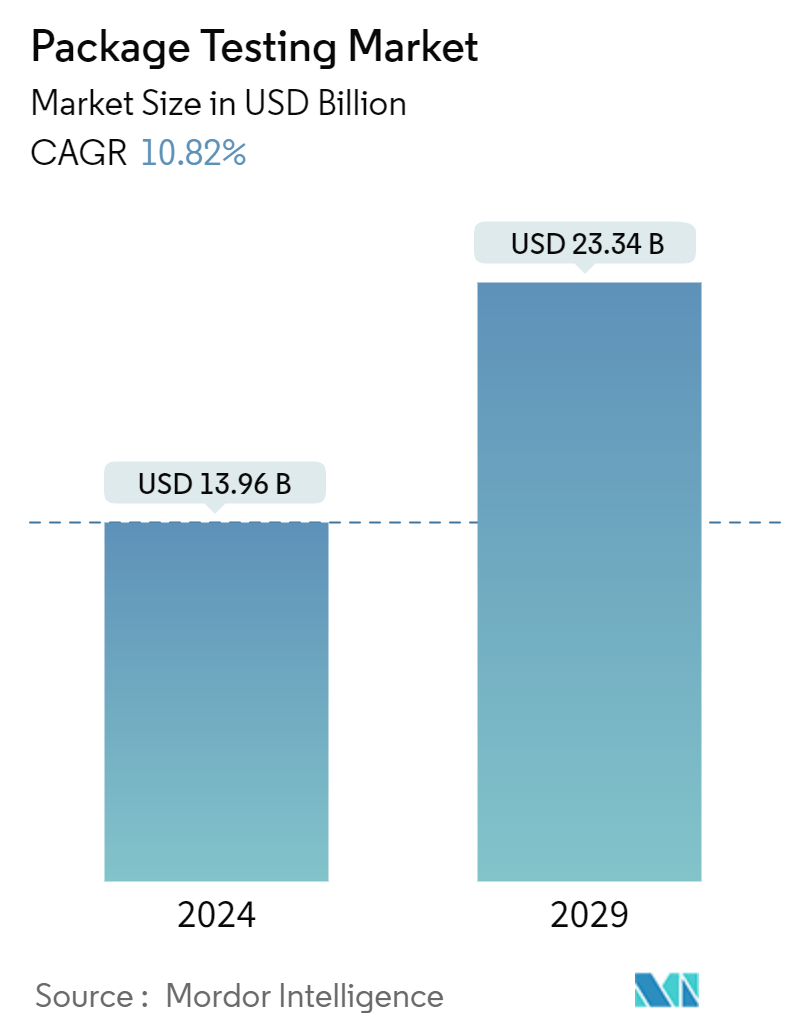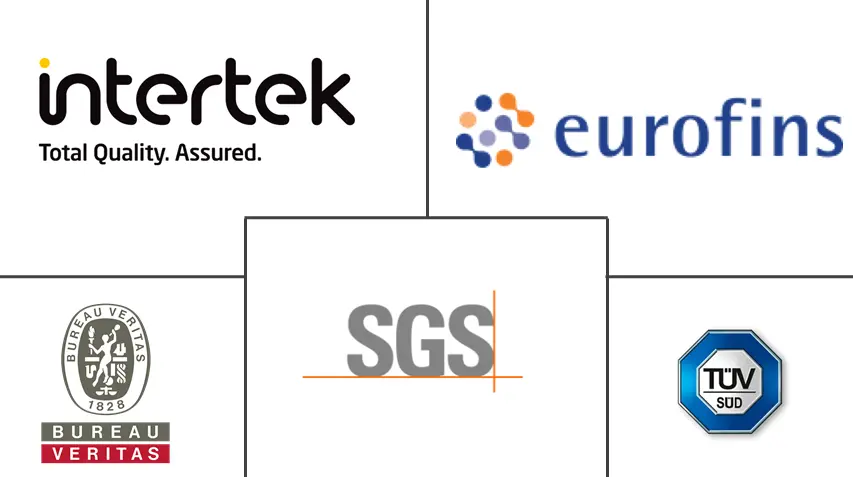Market Size of Package Testing Industry

| Study Period | 2019 - 2029 |
| Market Size (2024) | USD 13.96 Billion |
| Market Size (2029) | USD 23.34 Billion |
| CAGR (2024 - 2029) | 10.82 % |
| Fastest Growing Market | Asia Pacific |
| Largest Market | Europe |
| Market Concentration | Medium |
Major Players
*Disclaimer: Major Players sorted in no particular order |
Package Testing Market Analysis
The Package Testing Market size is estimated at USD 13.96 billion in 2024, and is expected to reach USD 23.34 billion by 2029, growing at a CAGR of 10.82% during the forecast period (2024-2029).
Package testing plays a prominent role in almost every supply chain. Package testing ensures the business's packaging meets specifications and avoids costly product damage, legal situations, and poor user experiences. Package testing identifies opportunities in several areas, such as savings on packaging costs, the performance of packaging materials in realistic environmental conditions and transportation scenarios, quality control insights, and scalability of packaging. It also includes compliance issues like certifications, specifications, and regulations.
- Globalization increased owing to trade liberalization, improvements in transport infrastructure and communication technologies, and the growth of multinational companies in the food retail sector. It boosted international trade in perishable foods like dairy, fruits, and vegetables.
- It made package testing even more important, as damaged products increase costs for retailers and manufacturers and lead to customer dissatisfaction. The reliability of the package is tested by performing numerous tests, such as drop, vibration, and shock tests, directed by standard institutions, such as the American Society for Testing and Materials (ASTM) and the International Seed Testing Association (ISTA).
- However, the costs associated with packaging testing are quite high, making it harder for small-scale manufacturers and industries to invest in this process, thereby hindering the growth of this market.
- Moreover, global and regional economic health significantly shapes the demand for packaged products, thereby fueling the necessity for packaging testing. Consumer spending shifts and buying habits directly alter the volume and intricacy of packaging, molding the packaging testing landscape.
- The packaging testing sector's fortunes are intricately linked to key industries like food and beverage, consumer goods, pharmaceuticals, and electronics. Swings in industrial output and manufacturing directly sway the appetite for packaging testing services.
Package Testing Industry Segmentation
Package or packaging testing involves measuring a characteristic or property involved in packaging. It includes packaging materials, components, primary packages, shipping containers, unit loads, and the associated processes. The study tracks the key market parameters, underlying growth influencers, and major vendors operating in the industry, which supports the market estimations and growth rates over the forecast period. The study further analyzes the overall impact of macroeconomic factors on the ecosystem.
The package testing market is segmented by primary material (glass, paper, plastic, and metal), type (drop test, vibration test, shock test, temperature test, and other types [compression testing, shelf life testing, and atmospheric temperature testing]), end-user industry (food and beverage, industrial, healthcare, household and personal care products, and other end-user industries), and geography (North America, Europe, Asia-Pacific, and Rest of the World). The market sizes and forecasts are provided in value (USD) for all the above segments.
| By Primary Material | |
| Glass | |
| Paper | |
| Plastic | |
| Metal |
| By Type | |
| Drop Test | |
| Vibration Test | |
| Shock Test | |
| Temperature Testing | |
| Other Types (Compression Testing, Shelf Life Testing, Atmospheric Temperature Testing) |
| By End-user Industry | |
| Food and Beverage | |
| Industrial | |
| Healthcare | |
| Household and Personal Care Products | |
| Other End-user Industries |
| By Geography*** | |
| North America | |
| Europe | |
| Asia | |
| Australia and New Zealand | |
| Latin America | |
| Middle East and Africa |
Package Testing Market Size Summary
The package testing market is poised for significant growth, driven by its critical role in ensuring packaging meets industry standards and prevents product damage, legal issues, and negative consumer experiences. As globalization and international trade expand, particularly in sectors like food retail, the importance of package testing has intensified. This market is influenced by various factors, including the need for compliance with certifications and regulations, the performance of packaging materials under different conditions, and the demand for cost-effective packaging solutions. The rise of advanced packaging methods, such as smart and modified atmosphere packaging, further underscores the necessity for rigorous testing to ensure product safety and integrity. However, high testing costs pose challenges for smaller manufacturers, potentially hindering market expansion.
The demand for package testing is closely linked to key industries such as food and beverage, consumer goods, pharmaceuticals, and electronics. Economic conditions and consumer spending patterns significantly impact the volume and complexity of packaging, shaping the testing landscape. In developed economies, particularly in the United States and Europe, the growth of packaged foods has driven robust demand for effective testing solutions. Regulatory frameworks, like the EU Packaging and Packaging Waste Directive, and industry standards from organizations such as ISO and ISTA, promote the adoption of package testing across various sectors. The market is semi-consolidated, with major players like Intertek Group, Eurofins Scientific, SGS, and Bureau Veritas maintaining dominance through innovative solutions. Recent expansions and acquisitions by these companies highlight the ongoing evolution and competitive nature of the package testing market.
Package Testing Market Size - Table of Contents
-
1. MARKET INSIGHTS
-
1.1 Market Overview
-
1.2 Industry Attractiveness - Porter's Five Forces Analysis
-
1.2.1 Bargaining Power of Suppliers
-
1.2.2 Bargaining Power of Buyers
-
1.2.3 Threat of New Entrants
-
1.2.4 Threat of Substitute Products
-
1.2.5 Intensity of Competitive Rivalry
-
-
1.3 Technology Snapshot
-
1.3.1 Package Integrity Testing
-
1.3.2 Package Strength Testing
-
1.3.3 Package Shelf-Life Studies
-
1.3.4 Package Validation
-
-
1.4 Assessment of Macroeconomic Factors on the Market
-
1.5 Industry Policies
-
1.5.1 ASTM Standards
-
1.5.2 ISO Standards
-
1.5.3 STA Standards
-
-
-
2. MARKET SEGMENTATION
-
2.1 By Primary Material
-
2.1.1 Glass
-
2.1.2 Paper
-
2.1.3 Plastic
-
2.1.4 Metal
-
-
2.2 By Type
-
2.2.1 Drop Test
-
2.2.2 Vibration Test
-
2.2.3 Shock Test
-
2.2.4 Temperature Testing
-
2.2.5 Other Types (Compression Testing, Shelf Life Testing, Atmospheric Temperature Testing)
-
-
2.3 By End-user Industry
-
2.3.1 Food and Beverage
-
2.3.2 Industrial
-
2.3.3 Healthcare
-
2.3.4 Household and Personal Care Products
-
2.3.5 Other End-user Industries
-
-
2.4 By Geography***
-
2.4.1 North America
-
2.4.2 Europe
-
2.4.3 Asia
-
2.4.4 Australia and New Zealand
-
2.4.5 Latin America
-
2.4.6 Middle East and Africa
-
-
Package Testing Market Size FAQs
How big is the Package Testing Market?
The Package Testing Market size is expected to reach USD 13.96 billion in 2024 and grow at a CAGR of 10.82% to reach USD 23.34 billion by 2029.
What is the current Package Testing Market size?
In 2024, the Package Testing Market size is expected to reach USD 13.96 billion.

